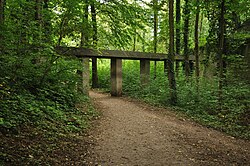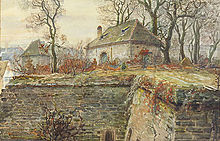Landau Fortress
| Landau Fortress | |
|---|---|
 Fortress aqueduct |
|
| Data | |
| place | Landau in the Palatinate |
| builder | Jacques Tarade |
| architect | Sébastien Le Prestre de Vauban |
| Client | Louis XIV |
| Architectural style | Baroque |
| Construction year | 1688-1702 |
| demolition | 1871 except for a few remains |
 Copper engraving with a plan view of the Landau fortress, during the siege of Landau (1702) |
|
The Landau Fortress was a polygonal fortress type in Landau in the Palatinate . The construction work took place between 1688 and 1691. In 1871 the completely outdated fortress was razed after it was downgraded to a depot in 1867. Almost all the systems that are below street level have been preserved. You can still see a number of military and residential buildings in the city, the lock systems and walls along the rivers, fortifications in parks, including the largest single system, the walls of the fort built in 1702 (with a total wall length of 3.3 km).
History of the fortress
After the Thirty Years' War , the imperial city of Landau was placed under the protection of France by the Peace of Westphalia from 1648. After the end of the Palatinate War of Succession in 1697, the city was also awarded under constitutional law to France in the Peace of Rijswijk in 1697, along with ten other Alsatian imperial cities . As the extreme eastern outpost of France, this place was therefore of great importance. In 1688, King Louis XIV ordered the fortress builder Vauban to convert Landau into a modern fortress. The old city walls were torn down and, with the help of sixteen royal battalions under the command of General Montclar and around 14,000 construction workers from the area, the renovation began in the spring of 1688, which was completed after three years. The 7 km long navigable Albersweiler Canal between the quarries near Albersweiler and Landau had previously been built to supply the construction site with building materials . During the reconstruction, straight, wide streets and squares for troops were created. In 1700, the engineer colonel Jacques Tarade built a crown work on the hill to the northwest , which additionally protected the fortress from this side. In 1702 the garrison of the Landau Fortress consisted of 4,095 infantry and 240 horsemen .
During the War of the Spanish Succession , a total of four sieges of Landau took place between 1702 and 1713 , each time the fortress fell to the besiegers. In 1702 the fortress was handed over to the imperial family, in 1703 it fell to the French again after the Battle of the Speyerbach, then in 1704 to the imperial troops again and finally to the French again in 1713. Further reinforcements took place in 1710, for example the Raveline , the Vorwerk also known as the crescent moon in the west of the main trench. The fort was expanded further in the years 1740–1742, when, among other things, the mine tunnels and the western escape and retreat gate were created. In 1793, during the coalition wars, the fortress was besieged by Prussian troops in vain.

After the fortress remained with France after the first peace in Paris, on November 3, 1815 the fortress was awarded as a federal fortress to the newly formed German Confederation . The peace garrison of the Landau Fortress originally consisted of 2,800 Bavarians . In the event of war, at the request of Bavaria , Baden had to provide a third of the war garrison, which had grown to a total of 6,000 men. After the formation of the reserve infantry division of the federal army , the composition of the occupation contingents of the federal fortress was changed. On March 3, 1831, the Federal Assembly decided that the war garrison of Landau from 4,000 Bavarians should be supplemented with the mixed contingents of the reserve division of 2,300 men. The governor and commandant of the Landau fortress were appointed by Bavaria, as it was transferred from Austrian to Bavarian jurisdiction in 1816. At the time of the German Confederation, numerous detached porches were built as part of significant expansion work, which withdrew the old city wall from the area of action of the enemy artillery .
During the Palatinate uprising , the Bavarian commander Wilhelm von Jeetze held the fortress from the beginning of May 1849 until it was relieved by the Prussians under Moritz von Hirschfeld on June 18, 1849.
construction
The basic shape of the fortress was an elongated octagon , the corners of which formed seven bastion towers and a large reduit . All around the inner area was closed off by a ditch. Thanks to a sophisticated lock system , the trench could be flooded if necessary. The outer works with a covered path lay in front of the ditch . Two gates led into the city ; one in the south and one in the north. The fortress was divided into two parts by the river Queich , the left, northern part of which could be effectively protected by flooding the present area. Two thirds of the fortress were almost unbridgeable by a wide and deep flood basin for onrushing troops. A narrow wooden bridge over the flood basin formed the only connection with the Kronwerk.
Parts received
Of the up to 198 works in the fortress, quite a few are still preserved today, but very few are openly visible or can be visited. Festungsbauverein Landau - les Amis de Vauban eV and city administration are working on a concept to make these above ground visible. From the main wall, the first in Vauban's 2nd manner, only the two gates are left today, the Porte de France (today: Franz. Tor) with a 40 m long piece of the Courtine and the Porte d'Allemagne (today: German Gate ) preserved. The largest preserved Vorwerk is the fort built by Jacques Tarade in Dutch style on the Kaffenberg in the north-west of the city, with over three kilometers of wall, upstream ravelines , mine tunnels, posterns and the most impressive part visible today. The trenches, outer works and glacis have formed the Luitpoldpark since the end of the 19th century and are now heavily overgrown. The campus of the University of Koblenz-Landau is located on the fort . In the north on Hindenburgstrasse is Lunette 55 , which once protected the distribution lock of the derivative canal, next to it in the north park a Couvre-Face . In the Ostpark you can see the eastern flank of Lunette 35 and a point, which the Beautification Society around 1900 gave the man-high coat of arms of the bastion tower No. 53 touched down. The fortress construction association has been uncovering Lunette 41 in the Savoyen and Goethe Park since 2012. This lunette has a tour d ' arçon , a defense tower, the only round structure in the otherwise angular fortress. The association is reconstructing the tower and bezel. The tower serves as an entrance for viewing the large tunnels ( mine passages ) under the southwest of the city. In the area within the fortress, the red barracks, the commandant's office, the town hall, the parade ground, the armory, the garrison church (Katharinenkapelle), the wooden hangar, inlet and outlet locks, parts of the ring, parts of the reduit buildings and many residential buildings of the French Baroque have been preserved .
literature
- Johannes Birnbaum : History of the city and federal fortress Landau: with related documents. Publisher: Kohlhepp. On commission: Tascher. Kaiserslautern 1830. Digitized
- Hans Hess: The Landau fortress - its construction and fate . In: Before times. History in Rhineland-Palatinate , Vol. IV, edited by Dieter Lau and Franz-Josef Heyen . Verlag Hermann Schmidt, Mainz 1988, pp. 141–166, ISBN 3-87439-177-9 .
gallery
Northwest bastion of the fort
Access Ravelin
Web links
- Landau Fortress
- History of the fortress on www.landau.de
- Landau fortress construction association - Les Amis de Vauban eV
- List of preserved fortifications





